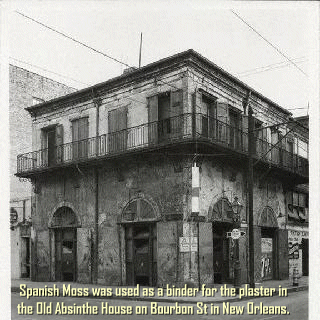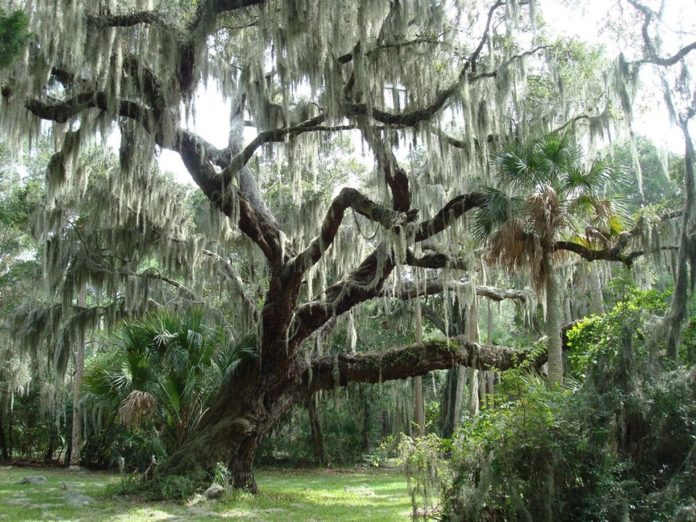A large part of the natural beauty of Beaufort and the rest of the South is the silver garland that hangs from our live oak trees. Spanish moss-draped oaks are the consummate image of the Lowcountry and are there just about everywhere you turn.
An image of beautiful Spanish moss hanging from majestic trees instantly reminds us of sultry summer days in the South. It’s a symbol of nature at its most relaxed.
But how much do you really know about Spanish moss?
Spanish moss isn’t Spanish, and it’s not moss
Spanish moss is part of the bromeliad family which places it in the same plant family as pineapples and succulent house plants. Spanish moss is actually native to Mexico, Central America, South America, the United States and the Caribbean where it can grow in a tropical environment. Here in the U.S. Spanish moss grows from Texas to Virginia generally staying in the moister areas of the south.
Spanish moss does not kill trees
That’s right. Contrary to popular belief, Spanish moss does not kill trees, limbs or branches.
If Spanish moss isn’t Spanish or a moss, how did it get it’s name?
Spanish moss was given its name by French explorers. Native Americans told them the plant was called Itla-okla, which meant “tree hair.” The French were reminded of the Spanish conquistadors’ long beards, so they called it Barbe Espagnol, or “Spanish Beard.” The Spaniards got back at them by calling the plant Cabello Francés, or “French Hair.” The French name won out, and as time went by Spanish Beard changed to Spanish moss. source
Spanish moss is an Epiphyte
Epiphyte: a plant that grows on another plant without directly gaining nourishment from it. Spanish moss receives all of its nutrients and moisture from the air and is not considered a parasite to the tree, it only uses the tree for support. The only damage it may cause is by breaking a weak limb. When the moss absorbs moisture its weight can increase tenfold. If there is enough bloated moss on a thin, weak, or dead limb it can cause the limb to break off.
It had many uses during the Civil War
The use of woven spanish moss blankets and saddle pads was adopted by Conferderate calvalry during the civil war. By the end of the war it was the most commonly issued blanket, which is probably not surprising considering its abundance in the south. It was durable and waterproof, did not chafe the horses, and allowed airflow and evaporation of horse’s sweat.

Spanish moss was once used for everyday items
Up until around 1960 Spanish moss was used for all sorts of everyday items such as stuffing for car seats and furniture. Native Americans would use Spanish moss to make bedding. They even made clothes by spinning the inner black core and using it as thread when cloth material wasn’t available. Moths are not drawn to Spanish moss in which upholsterers preferred to use over wool, until synthetic fibers replaced both.
Other uses for Spanish moss include: Lids for cooking pots, emergency blankets, insulation, mixed with clay to strengthen plaster, fiber woven into floor mats, to make string, rope and sacks, doll decorations and Voodoo doll stuffing. 
It’s a natural sponge and has been used as a covering to keep things from drying too fast, such as dug out canoes and cement. It also makes excellent mulch and the water it is boiled in is excellent fertilizer. Spanish Moss is often draped on chain link fences to create privacy.
There is evidence that Spanish moss was used over 3,000 years ago to make fire-tempered pottery. Although the moss burned away during the firing, the distinctive pattern of the fibers is still evident in the clay pottery. Spanish moss is still used today by many Native American tribes. For example, the Houma and the Koasati of present day Louisiana use Spanish moss in the construction and decoration of small dolls.
Birds and animals like Spanish moss
Many species use Spanish moss. Birds including warblers and orioles use it to build their nests. Rat snakes and at least three bat species live in Spanish moss. Boll weevils are especially drawn to Spanish moss, but moths are not, which is one reason it was preferred over wool in upholstery before synthetic fibers replaced both.
Other names for Spanish moss
Other common names for Spanish moss are Old Man’s Beard, White Beard, Spanish Beard, Florida Crape and Wool Crape.
Why does it mostly grow on older trees?
As mentioned earlier, Spanish moss is an epiphyte so its nourishment comes from dust and water in the air. Most importantly it receives nutrients from older (and dying) trees that are shedding dead cells which is the reason why Spanish moss is mainly seen on mature, slower growing trees.
Spanish moss doesn’t grow in polluted areas
Spanish moss is reported to be sensitive to air pollution. In areas where major pollution is present, Spanish moss is said to not grow at all.
There’s little chiggers living in it that will get on you if you touch it
Those who gather Spanish moss are warned against chiggers, but experienced collectors say chiggers only invade the moss after it touches the ground.
Now, after learning all of this, the next time you see Spanish moss, which may be in just a few minutes from now, you may think something different about it.
You’re welcome.










